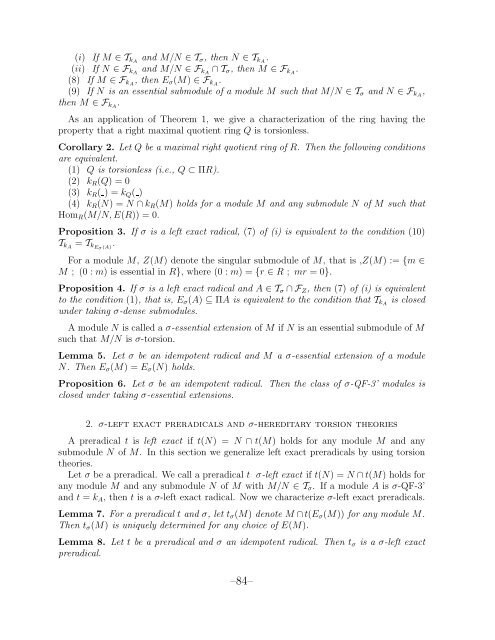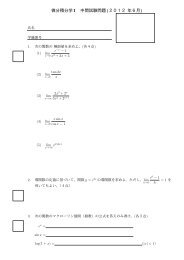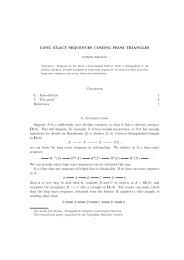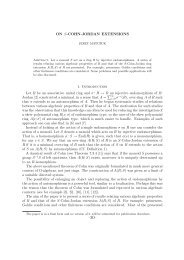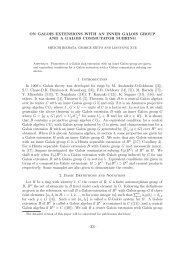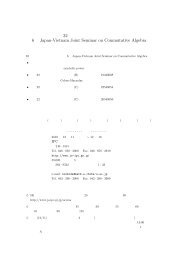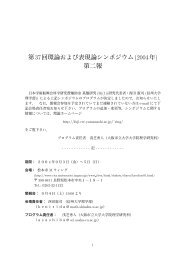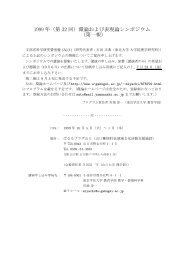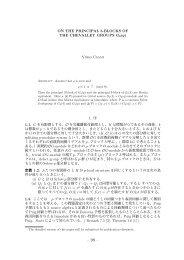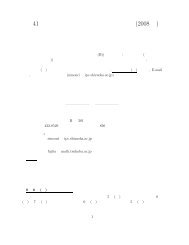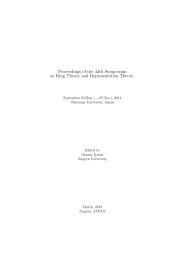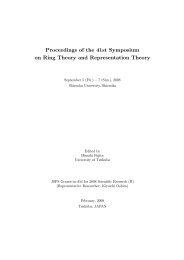Yasuhiko Takehana - FUJI
Yasuhiko Takehana - FUJI
Yasuhiko Takehana - FUJI
Create successful ePaper yourself
Turn your PDF publications into a flip-book with our unique Google optimized e-Paper software.
(i) If M ∈T kA and M/N ∈T σ , then N ∈T kA .<br />
(ii) If N ∈F kA and M/N ∈F kA ∩T σ , then M ∈F kA .<br />
(8) If M ∈F kA , then E σ (M) ∈F kA .<br />
(9) If N is an essential submodule of a module M such that M/N ∈T σ and N ∈F kA ,<br />
then M ∈F kA .<br />
As an application of Theorem 1, we give a characterization of the ring having the<br />
property that a right maximal quotient ring Q is torsionless.<br />
Corollary 2. Let Q be a maximal right quotient ring of R. Then the following conditions<br />
are equivalent.<br />
(1) Q is torsionless (i.e., Q ⊂ ΠR).<br />
(2) k R (Q) =0<br />
(3) k R ( )=k Q ( )<br />
(4) k R (N) =N ∩ k R (M) holds for a module M and any submodule N of M such that<br />
Hom R (M/N,E(R)) = 0.<br />
Proposition 3. If σ is a left exact radical, (7) of (i) is equivalent to the condition (10)<br />
T kA = T kEσ(A) .<br />
For a module M, Z(M) denote the singular submodule of M, that is ,Z(M) :={m ∈<br />
M ; (0 : m) is essential in R}, where (0 : m) ={r ∈ R ; mr =0}.<br />
Proposition 4. If σ is a left exact radical and A ∈T σ ∩F Z , then (7) of (i) is equivalent<br />
to the condition (1), that is, E σ (A) ⊆ ΠA is equivalent to the condition that T kA is closed<br />
under taking σ-dense submodules.<br />
A module N is called a σ-essential extension of M if N is an essential submodule of M<br />
such that M/N is σ-torsion.<br />
Lemma 5. Let σ be an idempotent radical and M a σ-essential extension of a module<br />
N. Then E σ (M) =E σ (N) holds.<br />
Proposition 6. Let σ be an idempotent radical. Then the class of σ-QF-3’ modules is<br />
closed under taking σ-essential extensions.<br />
2. σ-left exact preradicals and σ-hereditary torsion theories<br />
A preradical t is left exact if t(N) = N ∩ t(M) holds for any module M and any<br />
submodule N of M. In this section we generalize left exact preradicals by using torsion<br />
theories.<br />
Let σ be a preradical. We call a preradical t σ-left exact if t(N) =N ∩ t(M) holds for<br />
any module M and any submodule N of M with M/N ∈T σ . If a module A is σ-QF-3’<br />
and t = k A , then t is a σ-left exact radical. Now we characterize σ-left exact preradicals.<br />
Lemma 7. For a preradical t and σ, let t σ (M) denote M ∩ t(E σ (M)) for any module M.<br />
Then t σ (M) is uniquely determined for any choice of E(M).<br />
Lemma 8. Let t be a preradical and σ an idempotent radical. Then t σ is a σ-left exact<br />
preradical.<br />
–84–


